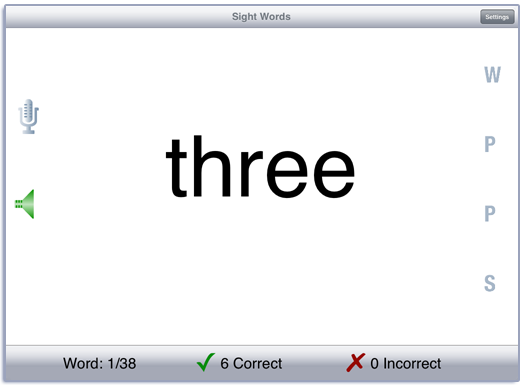
Studies have shown that good readers look at some words and automatically decode them. The Sight Words app lets beginning readers get a head start on learning these words. It also helps older students who are struggling with reading master the sight words.
There are 208 words organized by level of difficulty–Pre-Primer, Primer, Grade 1, Grade 2, and Grade 3. The colorful photos provide a visual cue for the word, The phrases and sentences help the student visualize the word in context.
Once the student is familiar with the words, from seeing them in context, use the Settings button to switch to the practice mode. The app will display 18 words on the screen—each of the words along with foils. The objective is to find three targets in a field of fifteen foils. Both the number of targets and the number of foils can be changed in the Options.
When the student is doing well in the Practice level, tap the Settings button to look at the options for the Challenge level. The Challenge level has foils that are not necessarily familiar to the student.
Target Audience Designed for neurotypical children ages K-3rd grade. Appropriate for children and adults having difficulty reading due to problems with with Auditory Processing, Auditory Conceptualization, Central Auditory Processing Disorders (CAPD), TBI, or Stroke.
Just $1.99 on the App Store.
See More Images
View the Wordlist
Information for Professionals
This app has three modes. In the Learn mode, a word is displayed on the screen. Each word has a picture, two phrases, and a sentence associated with it. To hear the word, tap the large text or picture or tap the speech production button labeled W. When you tap the speech production buttons a picture will appear on the screen with text below it. The text of the speech production can be hidden or displayed by toggling the “Show text below picture” button on the Options screen.
If the student identifies the word before the oral prompt, then score the word as correct using the Correct and Incorrect buttons at the bottom of the screen. Alternatively, you can score the student’s speech production. If the word was pronounced correctly, tap the green check. If the pronunciation was incorrect, tap the red x button. You can record and score as many times as you wish for each word.
Once the student is familiar with the words in a category, tap the Settings button to look at the options for Practice. On iPad tap the screen to start the Practice session. On iPhone, tap the play button. The app will display each of the words in the category along with foils. The default is to find three targets in a field of fifteen foils. Both the number of targets and the number of foils can be changed in the Options.
Once the student has mastered the Practice level, they may be up for a challenge. Tap the Settings button to look at the options for Challenge. The Challenge level has foils that are not necessarily familiar to the student. The default is to find three targets in a field of fifteen foils. At first the foils are words that (usually) have no letters in common with the target word. If the student finds all of the targets in less than 20 seconds per screen with few mistakes, the app automatically changes the foils to words that look more like the target. When all of the target words have been practiced, the app moves the student to the next level of difficulty—all words start with a capital letter. When all the words have been viewed, the app again moves to a more difficult level—words randomly starting with a capital or lowercase letter.
Rationale The goal of this app is to train the user to access the “word form region” of the brain located in the low posterior section of the parietal lobe. According to Dr. Sally Shaywitz (2003), this area allows the reader to look at a word and know automatically how to pronounce it, how to spell it, and to understand its meaning. Good readers show strong activation of this region in functional MRI studies. The speech model and time between presentations is designed specifically for those having trouble learning to read.